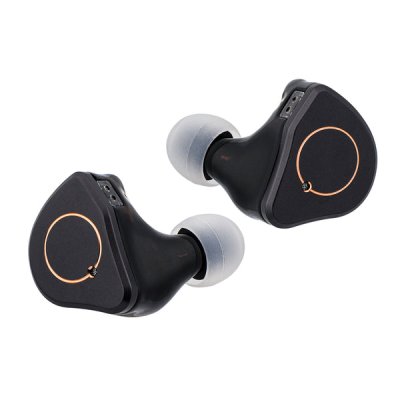Moondrop Blessing 3 and Simgot Supermix 4 use 2DD+4BA and 1DD+1BA+1Planar+1PZT driver setups respectively. Moondrop Blessing 3 costs $320 while Simgot Supermix 4 costs $150. Moondrop Blessing 3 is $170 more expensive. Moondrop Blessing 3 holds a slight 0.2-point edge in reviewer scores (7.1 vs 6.9). Simgot Supermix 4 carries a user score of 6. Simgot Supermix 4 has significantly better bass with a 1.4-point edge, Simgot Supermix 4 has slightly better mids with a 0.3-point edge and Moondrop Blessing 3 has significantly better soundstage with a 1-point edge.
Insights
| Metric | Moondrop Blessing 3 | Simgot Supermix 4 |
|---|---|---|
| Bass | 6.6 | 8 |
| Mids | 6.7 | 7 |
| Treble | 6.6 | 6.5 |
| Details | 7.2 | 6.9 |
| Soundstage | 7 | 6 |
| Imaging | 6.5 | 6.9 |
| Dynamics | 6 | 6 |
| Tonality | 6.6 | 6.7 |
| Technicalities | 7 | 7 |
Moondrop Blessing 3 Aggregated Review Score
Average Reviewer Scores
Average Reviewer Score:
7.1Generally Favorable
Simgot Supermix 4 Aggregated Review Score
Average Reviewer Scores
Average Reviewer Score:
6.9Cautiously Favorable
Reviews Comparison
Moondrop Blessing 3 reviewed by Tim Tuned
Youtube Video Summary
Moondrop Blessing 3 steps up as the most complete Blessing yet—cleaner and more controlled than the Blessing 2: Dusk, with less bass quantity but sharper dynamics and a tidier lower-midrange. It avoids the slight thinness some hear on Variations, keeping notes lean but satisfying. The midrange stays beautifully natural and a touch energetic without shout, while the biggest upgrade is in the treble: retaining the Dusk’s natural decay yet adding more air, so micro-details pop and vocals take center stage. The overall tilt is more vocal-forward and detail-focused than Dusk.
On the technical front, resolution sits around—or a notch above—the Timeless, with an impressively wide stage helped by reduced bass bleed and boosted upper air. Micro-detail is present but not laser-etched; separation could use that last half-step of incisiveness. Still, imaging, control, and clarity make for an easy “wow” on first listen, especially for listeners who value clean layering over sheer slam.
Comparisons are straightforward: versus the original Blessing 2, this is an upgrade across the board—cleaner lows, punchier bass quality, better lower-treble timbre, and comparable air. Versus Blessing 2: Dusk, choose Dusk for a more balanced and fuller bass hit; pick Blessing 3 for vocal presence, detail, and control. Against SoftEars Studio 4, Studio 4 sounds about a half-step more balanced with a touch more bass fullness and slightly better timbre, but the Blessing 3’s performance at roughly $320 is seriously competitive for the class. After a few underwhelming Moondrop releases, this feels like reclaiming the throne—a highly recommended return to form.
Tim Tuned Youtube Channel
Buy Moondrop Blessing 3 on Aliexpress
Ad
Price: $579
Buy Moondrop Blessing 3 on Aliexpress
Simgot Supermix 4 reviewed by Tim Tuned
Tim Tuned Youtube Channel
Buy Simgot Supermix 4 on Linsoul
Ad
Price: $149.99
Buy Simgot Supermix 4 on Linsoul
Moondrop Blessing 3 reviewed by Jaytiss
Youtube Video Summary
The Moondrop Blessing 3 is a 2DD + 4BA hybrid with a larger, premium-feeling shell that remains surprisingly comfortable—though size could be an issue for smaller ears. Accessories and build echo Moondrop’s recent releases (even the analog cable mirrors the Dusk’s), underscoring a cohesive design philosophy. Tuning skews a touch brighter and more analytical: airy upper-mids/treble, crisp detail retrieval, and clean separation, with lighter bass impact than some rivals. It’s a set that showcases “technicalities” in an immediately noticeable way.
Against the Crinacle x Moondrop Dusk, Blessing 3 trades some punch and warmth for extra sparkle and detail; Dusk offers more bass, slightly calmer treble, and a touch more “slam,” while Blessing 3 sounds airier and more incisive. Versus Variations, the graphs are similar and they trade blows, but Variations’ bass advantage struggles to justify the higher price for most listeners. Compared to Moondrop’s more affordable options (e.g., Aria 2) and value picks like TruthEar Hexa or AFUL’s Magic One, Blessing 3 delivers a more refined treble presentation and step-up resolution, while some mid-fi competitors around ~$600 don’t clearly outpace it in engagement or detail.
Priced ~$330 (often on sale around $280), Blessing 3 sits at the sweet spot before diminishing returns hit hard. The trade-offs are clear: a touch bright, bass-light for those craving heft, and not the absolute value king next to Dusk—but as an airy, detailed, well-built daily driver, it’s easy to recommend. Final call: a strong A-—especially fitting for treble-heads and anyone seeking a clean, modern Moondrop tuning without paying flagship prices.
Jaytiss Youtube Channel
Simgot Supermix 4 reviewed by Jaytiss
Youtube Video Summary
Build and comfort are front-and-center: a cozy shell with a metal faceplate, excellent ergonomics, and easy tip fitment. The red/blue two-pin sockets and the gunmetal cable add a premium touch, while the case is the familiar, functional Simgot pouch. Hype is warranted at least on construction—this is the most comfortable Simgot shell in the lineup so far.
Sonically, Supermix 4 follows a Harman-style curve with clean channel matching, solid resolution, and bass that balances sub-bass presence with controlled mid-bass. Treble can “touch the sun”—slightly bright on certain tracks—and the very low impedance makes it source/tip sensitive; tip rolling and even a basic Apple dongle often settle it down. Technicalities are strong for the price: clarity, shimmer on cymbals, and lifelike guitars impress, though some will crave a smoother top end.
Against peers, it surpasses EW200 in refinement and comfort and feels like a cleaner, easier-to-live-with replacement for EM6L. Compared with AFUL Explorer, this is the more forward/bright take versus Explorer’s laid-back vibe; versus CCA Hydro, vocals are steadier while Hydro punches harder down low. Kiwi Ears Quintet shows similar intent but has quirks around 10 kHz; DaVinci is a touch more refined yet pricier, and some will prefer Supermix 4’s shell and value. Net result: a strong recommendation for listeners wanting a comfortable, versatile, mildly vivid IEM that competes above its bracket—great for music and even gaming—so long as a hint of brightness is acceptable.
Jaytiss Youtube Channel
Moondrop Blessing 3 reviewed by Jays Audio
Youtube Video Summary
Moondrop Blessing 3 brings excellent resolution, clarity, and layering, with a clean, transparent tonality that skews bright-leaning neutral. Treble is extended without being splashy, giving plenty of air to cymbals and female vocals, while the midrange stays unmasked and articulate—piano and guitar transients pop with crisp decay. Staging is open and airy with pinpoint imaging (not wrap-around holographic like the biggest stage monsters), and the bass is snappy, tight, and bleed-free. The catch: the low end sits back, so on certain tracks the presentation can feel light, and a 6 kHz rise can get spicy at louder volumes depending on the song; vocals may lean a touch thin in classic Moondrop fashion.
Compared to Blessing 2, it’s a clear step up in cleanliness, note definition, and separation. Versus Dusk, think side-grade: a slightly brighter tilt and less bass weight, trading some low-end texture/extension for more air and edge definition. The set responds very well to EQ—a ~+5 dB low shelf @ 60 Hz (Q 0.5) and about −1.5 dB @ 6 kHz (Q 3) adds punch and reins in glare; with this, it approaches Variations performance while filling in mid-bass a bit. Simple nozzle filters (e.g., Alina/Tanchjim-style) can also tame upper mids and nudge bass up. For listeners who want more slam and tamer highs, stock tuning won’t be the endgame; for those preferring a clean, airy, detail-forward neutral, Blessing 3 is pretty banging at its price and technically competitive with pricier sets (think RS5, Oracle, even EGL7M on technicals, though the latter still stages wider). If Moondrop’s house sound clicks, it’s an easy rec; if not, look at cheaper options like Hexa or keep an eye out for a potential B3 “Dusk” variant.
Jays Audio Youtube Channel
Simgot Supermix 4 reviewed by Jays Audio
Youtube Video Summary
SIMGOT Supermix 4 comes out swinging: a quad-brid with both planar and PZT drivers that somehow sounds buttery smooth and shockingly coherent—more like a single driver than a parts bin. Upper-mids and treble sit neutral and refined, avoiding the usual glare; tuning reads as Harman 2019 done right—what feels like endgame Harman. Versus sets like Supernova/Nova/Chopin, the SM4 brings cleaner extension, higher resolving power, and a smoother, more polished treble where cymbals and consonants land naturally. Note this is a pre-production unit, so final tuning may still shift.
Bass quantity measures lower than some peers, but that puts the low end in the background and boosts separation, layering, and transient clarity; texture is tidy, impact respectable, and decay well-judged. Vocals are a highlight—accurate, balanced, complete in extension, and consistently non-fatiguing. Treble adds a sprinkle of liveliness without turning sharp. In A/Bs: it feels like a cleaner, more energetic Origin; a smoother, more technical all-rounder than CK LVX/Pula (though those keep a fuller, dreamier flavor); trades blows with Dusk (Dusk hits harder and runs brighter, SM4 wins mid/upper-mid detail and vocal completeness); and out-separates Hype 4 while Hype 4 remains the bigger, bassier fun pick. As an all-rounder this is top-tier; if priced around Dusk/Hype 4 it’s a strong value, while a ~$500 tag would push it into diminishing returns.
Jays Audio Youtube Channel
Moondrop Blessing 3 reviewed by Yifang
Youtube Video Summary
Moondrop Blessing 2:Dusk brings a rock-solid build with clear acrylic shells that show off the 1DD+4BA internals and that cheeky anime engraving. Fit skews large—big nozzles and a bulky body—so smaller ears may struggle. The included “sweat guards” are basically stickers that tend to come off with the tips, and taking these to the gym is a bad idea (moisture can cause issues). The real sin is the stock cable: thin, microphonic, and fragile—swap it immediately. On the upside, customer service/warranty is legit if something goes wrong.
Sonically, this tuning is a crowd-pleaser. The bass extends deep for a DD and slams without bleeding, the mids are the highlight—acoustic instruments and vocals sound fantastic—and the treble is clean but can push toward fatigue for sensitive listeners or on bright EDM drops. For electronic genres (hardstyle, D&B), the low-end grip is addictive; for orchestral and vocal music, it’s as close to “set and forget” as it gets. Quick fix if the top end nudges too hot on desktop: a simple EQ cut—~−4.5 dB @ 8 kHz (Q≈1)—tames the edge and lets the volume come up for extra bass satisfaction.
Technical chops are strong: resolution pops micro-details without turning clinical, soundstage width sits in the higher percentile for the price, and dynamics swing convincingly from soft to slam. Imaging is fine, but positional distance (for Valorant/CS-style footsteps) isn’t the strength—Apex/Overwatch or media use is totally fine. Net takeaway: as an everyday all-rounder for music, games, and movies around this bracket, it’s a killer pick with just two caveats—skip the stock cable and avoid sweaty workouts—or EQ the treble if sensitive.
Yifang Youtube Channel
Simgot Supermix 4 reviewed by Yifang
Moondrop Blessing 3 reviewed by Gizaudio Axel
Gizaudio Axel original ranking
Gizaudio Axel Youtube ChannelSimgot Supermix 4 reviewed by Gizaudio Axel
Gizaudio Axel original ranking
Gizaudio Axel Youtube Channel
Moondrop Blessing 3 reviewed by
 Fresh Reviews
Fresh Reviews
Youtube Video Summary
Moondrop’s Blessing 3 pushes a distinctly airy, high-clarity take on competitive audio. The stage feels a touch farther from the head, with solid imaging, depth perception, and verticality, but it walks the edge of “how far is too far” for games like Valorant and Apex. Detail retrieval up top is crisp and separation of higher-frequency cues is clean, yet the set could use a bit more immediacy and extra sub-/mid-bass to weight deep thumps and footsteps. Once ears adjust, performance is strong, though the bright tilt can be fatiguing for some. The see-through shell with a metallic faceplate is slick; accessories are fine but basic at this price ($310), with tips and cable that invite swapping.
Against Dunu’s SA6 MK2, the Blessing 3 sits on the “open/bright” end while the Dunu plays “closer/warmer,” delivering more urgency from its fuller low end—but that extra mid-bass can blur layering and separation when many similar cues trigger at once. For pure game sense, both have Wallhack Certified potential, just not near the top; sets like Kiwi Ears Orchestra Light (V2) strike a smarter middle ground with better balance for mixed scenarios, and options such as Dunu Vulkan or Raptgo Hook-X can edge them out. Ergonomics are good on both; the SA6 MK2’s “Mini Hulk” cable and swappable plugs (4.4/2.5/3.5) and generous tip spread help justify its higher tag ($579). Summary: choose Blessing 3 for a brighter, wider, cue-separating presentation; choose SA6 MK2 for a nearer, meatier hit—while the Orchestra Light V2 remains the safer, game-first recommendation.
Fresh Reviews original ranking
Fresh Reviews Youtube Channel
Simgot Supermix 4 reviewed by
 Fresh Reviews
Fresh Reviews
Youtube Video Summary
Supermix 4 emerges as the standout of Simgot’s quartet for both fit and build, pairing a classy brushed bronze faceplate with the most refined tuning of the group. As a quad-brid, it delivers superior cleanliness, imaging, and depth perception versus EM6L, EA1000, and EA500LM, with tighter separation and more micro-detail; its presence region feels a touch more laid-back than EA1000, keeping gunshots from turning shouty. Footsteps could be slightly more elevated for sweaty lobbies, but that’s easily addressed with EQ while preserving the set’s natural balance.
Across titles it’s the most dependable all-rounder: in Valorant, the added cleanliness and precision outclass EA500LM (bloated, spicy gunshots) and nudge ahead of EM6L/EA1000; in Rainbow Six Siege, clarity, separation, and positional cues make it the clear pick. Call of Duty is closer—EA500LM is a solid budget choice and EA1000 can get intense—but Supermix 4 still pulls more footstep detail while staying composed; in Apex Legends it trades blows with EM6L yet edges ahead with extra information retrieval. Overall verdict: Supermix 4 wins, with EM6L in second, EA1000 around B-, and EA500LM around C+; a clean, precise, and thoroughly engaging pick for competitive and casual gaming alike.
Fresh Reviews original ranking
Fresh Reviews Youtube ChannelMoondrop Blessing 3 reviewed by Head-Fi.org
Simgot Supermix 4 reviewed by Head-Fi.org
Moondrop Blessing 3 (more reviews)
Moondrop Blessing 3 reviewed by Super* Review
Youtube Video Summary
Moondrop Blessing 3 sticks to the family recipe—clean, neutral, vocal-centric—while fixing the Blessing 2’s soft spot: treble extension. Cymbals finally have proper metallic sheen and decay, and the overall imaging/separation step up. Bass comes from a dual-DD setup that favors control over quantity: tight, springy, and articulate in the sub-bass without turning the set “bassy.” Vocals are outstanding for the price—transparent, textured, and front-and-center. Physically, it’s the familiar large 3D-printed acrylic shell with a slimmer ~5.7 mm nozzle for easier tip fit, glossy metal faceplates that love fingerprints, an improved but still slightly memory-prone cable, a chunky case, and lots of tips (but no Spring Tips). Price stays put at $320.
The one nitpick: a noticeable upper-bass/lower-mids scoop that trades warmth and body for clarity. With modern productions that already carry sub-bass, the presentation feels deep and precise; with leaner acoustic or classic rock, it can read a touch sterile. Versus peers: Blessing 2 is a hair warmer and fuller but less extended up top; Blessing 2 Dusk shares the mid scoop, adds more sub-bass, and keeps the older treble quirks; Soft Ears Studio 4 is similarly lean-neutral with a bigger stage but smoother BA timbre; Kiwi Ears Orchestra Light is warmer, punchier in mid-bass, and more laid-back with weaker separation. Even with the tonal quibble, this is a clear upgrade—a “nearly perfect” neutral set and an easy 5/5.
Super* Review original ranking
Super* Review Youtube ChannelMoondrop Blessing 3 reviewed by Z-Reviews
Youtube Video Summary
Moondrop Blessing 3 ditches the old vibe for a fresh hybrid recipe: H.O.D.D.U.S. (two horizontally opposed 10 mm dynamics) plus 4× BA at around $320. The stage isn’t huge, by design—this is an intimate, in-the-head presentation that puts the music right up front. Bass is quick, tight, and more about responsiveness than brute slam; treble is crisp without splash, and nothing feels exaggerated. The crossover is impressively cohesive—no obvious handoff between DDs and BAs—yielding a “mixing/mastering” sort of neutrality with excellent detail retrieval and control. Think subtle-but-capable: delicate when it should be, instantly punchy when it must.
Build is peak Moondrop showpiece—shiny stainless backplate, clear acrylic shell showing the guts, and a comfy fit—but the stock 3.5 mm cable is underwhelming. The box is over-engineered fun; the tips selection is one silicone type in many sizes (foam not ideal here). Tip rolling to something like Dunu S&S keeps bass honest. Amp pairing prefers clean, linear gear; warm hybrids can push mids oddly, while neutral solid-state keeps things balanced. Not hard to drive (~12 Ω). Skip if you crave gobs of soundstage; absolutely grab if the goal is a neutral, close-up, fast, and coherent listen that “force-feeds” the music—without the fatigue. A confident buy for presence and precision.
Z-Reviews Youtube Channel
Moondrop Blessing 3 reviewed by Shuwa-T
Moondrop Blessing 3 reviewed by Precogvision
Precogvision Youtube Channel
Moondrop Blessing 3 reviewed by Nymz
Simgot Supermix 4 (more reviews)
Simgot Supermix 4 reviewed by Audio Amigo
Audio Amigo Youtube Channel
Simgot Supermix 4 reviewed by Kois Archive
Kois Archive Youtube Channel
Simgot Supermix 4 reviewed by Web Search
The Simgot Supermix 4 packs a quadbrid driver configuration (1DD+1BA+1 Planar+1 PZT) into a comfortable resin shell. Its sound follows a U-shaped signature aligned with the Harman IE 2019 target, emphasizing sub-bass rumble and crisp upper-midrange clarity while keeping lower mids slightly recessed. The bass is deep and textured, though mid-bass punch can feel soft, and vocals sometimes edge into shoutiness at higher volumes.
Treble delivery is a standout, with the planar and PZT drivers offering snappy articulation and air without harsh sibilance. Technical performance is strong for the price, featuring a wide soundstage and precise imaging that excels in gaming scenarios. However, low impedance makes it source-sensitive, and accessories feel minimal with only one set of tips included.
While not class-leading in resolution, the Supermix 4 delivers cohesive tonality across its diverse drivers, making it a versatile choice for bass-forward genres and competitive gaming. Its slight warmth and holographic staging compensate for minor midrange thinning, offering solid value despite fierce competition.
Moondrop Blessing 3 Details
Driver Configuration: 2DD+4BA
Tuning Type: Neutral
Brand: Moondrop Top Moondrop IEMs
Price (Msrp): $320
Support our free service! Buying through our affiliate links costs you nothing extra:
Simgot Supermix 4 Details
Driver Configuration: 1DD+1BA+1Planar+1PZT
Tuning Type: U-Shaped
Brand: Simgot Top Simgot IEMs
Price (Msrp): $149.99
Support our free service! Buying through our affiliate links costs you nothing extra:
Moondrop Blessing 3 User Review Score
Average User Scores
Average User Score: n/a
Based on 0 user reviews
No user reviews yet. Be the first one who writes a review!
Simgot Supermix 4 User Review Score
Average User Scores
Average User Score:
Based on 1 user reviews
6Mixed to Positive
Moondrop Blessing 3 Gaming Score

Gaming Score & Grade
- The gaming score is prioritizing technical capabilities of the IEM (Separation, Layering, Soundstage) and good value.
Gaming Score
6.6Gaming Grade
B+Simgot Supermix 4 Gaming Score

Gaming Score & Grade
- The gaming score is prioritizing technical capabilities of the IEM (Separation, Layering, Soundstage) and good value.
Gaming Score
7.1Gaming Grade
A-Moondrop Blessing 3 Scorings
Average Technical & Tuning Grades
Average Tunign Grade
B+- Expect a friendly tonal balance that could use polish but remains inviting. Great for casual listening, less so for purists.
Average Technical Grade
A-- Overall technicalities are acceptable, delivering enough clarity for casual sessions. Imaging is serviceable though not immersive.
Simgot Supermix 4 Scorings
Average Technical & Tuning Grades
Average Tunign Grade
B+- It sounds pleasant overall, with some uneven spots that hint at room for refinement. Vocals remain pleasant despite the imperfections.
Average Technical Grade
A-- It manages detail and layering well enough, even if the stage feels only moderately sized. You get a clear sense of left and right, if not depth.
Moondrop Blessing 3 User Reviews
"This is an example review"
Pros
- Example pro 1
- Example pro 2
Cons
- Example con 1
- Example con 2
Share your experience and build your personal ranking list.
You need to be signed in to write your own reviewSimgot Supermix 4 User Reviews
Share your experience and build your personal ranking list.
You need to be signed in to write your own reviewBetter tuned options at this price range.
Pros
Responsiveness to EQCons
Typical harman IEM tuning - thin bodied and honky sounding.Buy Simgot Supermix 4 on Aliexpress
Ad
Price: $149
Buy Simgot Supermix 4 on Aliexpress
Find your next IEM:
IEM Finder Quiz
newIEM Comparison Tool
newVS





























